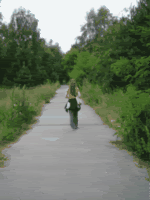Sharp city borders & green belt
The so-called “sharp city borders” of Berlin probably made the biggest visual impression on us today. The term expresses the fact that in former outer-border areas you see dense urban development right up to the city borders, where it then suddenly stops and country-side with wide, empty spaces opens: no urban sprawl – just a deep, sharp cut.
The reason why we see this is very simple. Due to the restricted space in the encircled western part of the city, dense housing developments went right up to the wall. The Eastern German government was not interested in development close to the borders as this made the wall much more difficult to control from escape attempts. Unlike in the case of the inner-city border, it was no big problem to keep the areas in front of the Eastern side of the wall free – the birth of the sharp city corners.
Walking along these sharp city borders was astonishing, but feels a bit unreal as well. It must have been a bit like this for the resident of the Lego towns, which I built when I was young: they never sprawled as there was a constrain on development from the limited number of pieces I owned, my attention span was too short and my lust for destruction too big to allow for any longer period of city development. So there were always dense development clusters in an open landscape: my Lego city residents could always go straight from their house into the jungle.


Picture 1: Sharp borders at Gropiusstadt today
Picture 2: Sharp borders at Gropiusstadt in divided Berlin
This is how it still is in many places at the outer-city border of Western Berlin. It is pretty cool to walk from a densely populated suburb into the countryside in absolutely no time. It is pretty freaky that you could not do this for a long time and would have hit a wall instead.
The sharp city borders are probably most visible in Gropiusstadt. Gropiusstadt is one social hotspot in Berlin with dozen of high-rise estates that became world famous with the story of Christiane F., who grew up there. But wherever we went it was tricky for us to document the sharp borders on photos with our crappy little pocket camera. Ultimately we found a nice, old picture at one of the information points along the way – the resulting “meta-picture” shows it well.
The protected wall area has developed in most places at the outer city border into a green belt of spontaneous vegetation similar to the one at the inner German border, which has become a nature reserve (http://en.wikipedia.org/wiki/German_Green_Belt). Unfortunately, unlike to its “big sister”, the green belt around Berlin will probably not be protected. The land owned by the federal state of Brandenburg is pretty valuable – and let’s be honest: who on earth except David Attenborough does really care about these snails and worms and rats and trees and plants anyway.

Picture 3: 'Kolonnenweg' in the green belt of Berlin
Cold War economics
Even though I am pretty familiar with the concept of footprinting and its application to cities, I never really thought about how life was maintained in Western Berlin. Clearly, there was not sufficient space available to provide all the resources and absorb all the wastes of the resident population in West-Berlin. I knew that most food and other resources were flown in initially and later transported in by road via the transit passage between West-Berlin and West Germany. But what about the waste? It would have been crazy to ship it all back to West-Germany.
So – there was an incentive to maintain economic relationships between East and West Berlin right from the start of the Cold War. West Berlin was interested in getting rid of its waste. East Berlin was interested in “hard” West-German currency. So they started to trade millions of tons of waste over the years.

Picture 4: Rail track for waste transportation between East and West Berlin
Similarly, to attract valuable foreign currency the East German government built a special transit passage to make the Eastern Berlin airport Schönefeld easily accessible for Westerners without the complicated passport control procedures. For visitors and residents of West Berlin Schönefeld provided an attractive alternative, as flights to some European destinations were offered at cheaper rates. Regardless of all hostile perceptions at the time, these offers were sometimes too good to be declined. Cold War economics.
Ownership
We went to a symposium of the exihibition “Neues Licht auf das Sperrgebiet” at the Deutsches Architektur Zentrum (DAZ) (see beginning of this blog). The discussion – badly moderated – revealed an interesting issue we have not been aware of so far. When the Eastern German government dispossessed people of their land to build the wall, they put in place a law saying that in case of its fall, people would get their land back. In the reunited Germany, a similar practice was generally followed to deal with issues of land dispossession in Eastern Germany, but not in the case of land of the former inner German borders – henceforth referred to as “border land”.
Border land continued to belong to the German government. If the land was needed for development, the rightful land owners were entitled to a compensation of 75% of the market value. Otherwise they had the chance to buy it back for 25% of its market value. If they did not want to buy it back or did not have the means to, it remained in state ownership. Ultimately, border land owners were dispossessed twice. A darker chapter of the young history of the united Germany.

Keine Kommentare:
Kommentar veröffentlichen